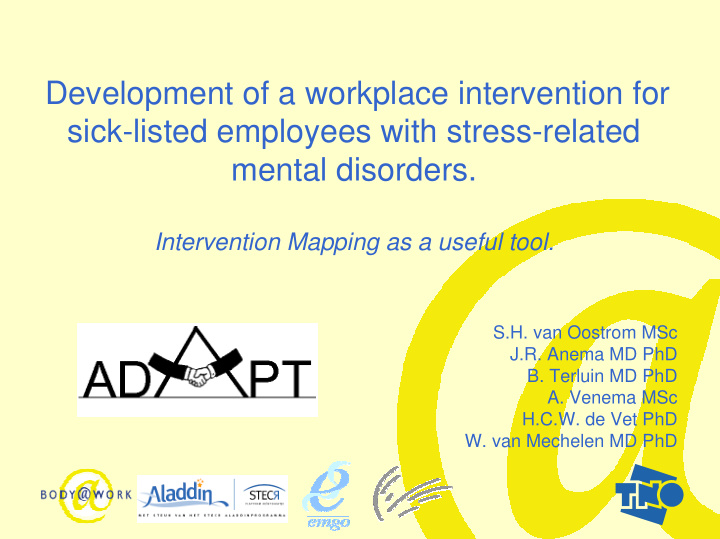



Development of a workplace intervention for sick-listed employees with stress-related mental disorders. Intervention Mapping as a useful tool. S.H. van Oostrom MSc J.R. Anema MD PhD B. Terluin MD PhD A. Venema MSc H.C.W. de Vet PhD W. van Mechelen MD PhD
Background • Mental health problems are increasingly related to disability and sick leave. • Discussion about mental health problems at work is experienced to be difficult (Anema 2003, Jettinghof 2005). • Work adaptation advised to prevent long-term sick leave (guidelines OP the Netherlands).
Participatory Workplace intervention • A stepwise process with employee and supervisor: 1. to identify barriers for RTW. 2. to think about solutions. 3. to formulate an RTW plan based on consensus. 4. to implement and evaluate work adaptations. • Reduced sick leave due to LBP with 27 days (Anema 2007). • Positively evaluated (Anema 2003). • Identification and discussion about mental workload and stress (Jettinghof 2005).
Research objectives • To develop a workplace intervention for sick-listed employees with stress-related mental disorders (SMDs). • Applying Intervention Mapping (IM) principles to tailor the intervention to this specific target group.
Intervention Mapping • For theory-based and evidence-based health education programmes (Kok et al, 2004). • To adjust the existing workplace intervention. • To facilitate implementation by involving stakeholders.
Feasibility and theory • Need and support system of intervention available. • Theoretical framework – Focus on RTW behavior (Frank 1998, Shaw 2001, Shrey 1996). – Important determinants of RTW: Attitude, Sociale influence, Self-efficacy (Krause, Young, Labriola, Arnetz, MacEachen, Shaw)
Intervention objectives • Program objective – Employees with SMDs should achieve RTW early and safely by reducing barriers for RTW. • Target group – SMDs: distress and psychosocial disfunctioning (Terluin 2007). • Matrices of objectives and practical strategies.
Program plan • Focus group interviews – Recently sick-listed employees with SMDs – Supervisors – Occupational health professionals • Themes of focus groups – Equality, safety and support in discussions about RTW. – Role of the RTW coordinator. – Preconditions before starting with the workplace intervention. – Expected practical barriers for the workplace intervention.
About equality, safety and support… ‘In spite of being able to get on well with my supervisor, I found talking about RTW very difficult.’ ‘ This protocol can provide structure, and offers a framework that is useful for both employee and supervisor.’ ‘There is a difference in authority in such a conversation with your supervisor. It would be helpful if someone monitored this process.’
About the RTW coordinator and preconditions for the intervention… ‘An intermediary must have certain expertise.’ ‘An employee has to be able to look from some distance at his problems; this is not possible when he/she has, to a great extent, lost control.’ ‘I needed rest in the first weeks of sick leave. That is not the best time to start having these conversations.’
Changes intervention by means of IM • Start intervention after 4 weeks of sick leave. • OP can plan extra consults for stress reduction. • Stressor inventory. • RTW can contribute in getting back some control. • Communication with primary care physicians.
Implementation and evaluation plan • Development of training for OPs and RTW coordinators. • Design of the RCT about cost-effectiveness of workplace intervention for sick-listed employees with SMDs.
Conclusion • Application of IM in the field of occupational health is promising but time consuming. • IM is an useful tool to consider each decision in the development, implementation and evaluation phase of an intervention. – Development of a theoretical framework. – Input from several stakeholders.
Discussion • Implementation of evidence-based RTW interventions in occupational health has been difficult (Goldenhar 2001). • Could a process as IM offer an opportunity to improve implementation?
First results are available in 2008. Thanks for your attention! Publication: BMC Health Services Research, 2007 Sandra van Oostrom EMGO Institute, VU Medical Centre Amsterdam, The Netherlands Sandra.vanoostrom@vumc.nl
Recommend
More recommend